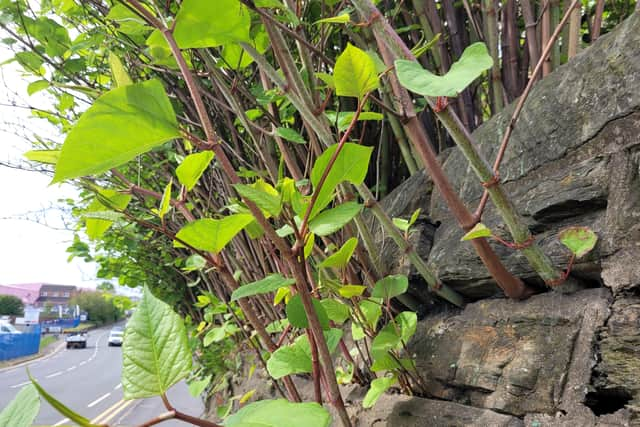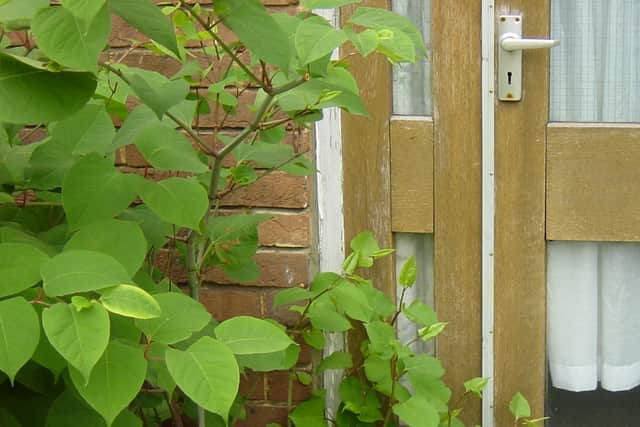Bolton identified as national hotspot for Japanese knotweed - how to spot the plant and what to do about it
and live on Freeview channel 276
Bolton has been identified as a national hotspot for the invasive plant Japanese knotweed - and other areas in Greater Manchester which have issues with it have been revealed.
Environet UK has an interactive heatmap where people can record sightings of the problematic plant in their areas.
Advertisement
Hide AdAdvertisement
Hide AdThe reporting tool has more than 55,000 sightings of Japanese knotweed on it and the results have now been analysed to see where issues are most commonly typed in.
The firm has also released advice on what homeowners should do if they see Japanese knotweed or have problems with it.


What does the reporting tool show for Japanese knotweed in Greater Manchester?
The reporting tool suggests the most common place to find issues with Japanese knotweed in the city-region is in Bolton, with 684 infestations within a 4km radius identified in the three years or so since the online heatmap was launched.
Not only does this top the Greater Manchester table, it is also the most of any location across the country.
Advertisement
Hide AdAdvertisement
Hide AdOther city-region hotspots include Ramsbottom (176 infestations), Glossop (140) and Salford (120).
How does the heatmap work?
Sightings of Japanese knotweed can be uploaded to the heatmap, with users asked to give their location and a photo so experts can verify that they have spotted the right plant.
The reporting tool also asks for the size of the infestation and there are a few other optional questions as well.
Once an infestation has been identified it will not be removed from the site.
Advertisement
Hide AdAdvertisement
Hide AdIn the three years since Environet UK started its crowdsourcing efforts to see how widespread the problem is some 55,000 sightings have been recorded on the heatmap.
It should be pointed out that Environet UK is not the only concern using similar methods to track the prevalence of Japanese knotweed.
The Japanese Knotweed Agency, for example, has an interactive map which it is calling a national register with some 23,000 sightings of the plant recorded on it.
Its numbers are given for the first part of each postcode, rather than being added together for an area with a 4km radius as Environet UK has done.
Advertisement
Hide AdAdvertisement
Hide AdIf you would like to compare the data, the Japanese Knotweed Agency’s map can be viewed here.
What is Japanese knotweed and why is it a problem?
Japanese knotweed first arrived in UK in 1850 in a box of plant specimens delivered to Kew Gardens in London.
Favoured for its rapid growth and pretty heart-shaped leaves, it was quickly adopted by gardeners and horticulturalists who were oblivious to its invasive nature.
Knotweed hibernates over winter but in March or April it begins to grow, with red or purple spear-like shoots emerging from the ground which quickly grow into lush green shrubs with pink-flecked stems and bamboo-like canes.
Advertisement
Hide AdAdvertisement
Hide AdFor homeowners, the plant can pose serious problems if left unchecked, with the potential to grow up through cracks in concrete, tarmac driveways, pathways, drains and cavity walls.


The roots can grow as deep as three metres and spread up to seven metres horizontally.
While serious damage to property is rare thanks to regulation which requires knotweed to be dealt with when a property is sold to a buyer using a mortgage or if it encroaches across a garden boundary, it commonly impacts use of the garden, causes legal disputes between neighbours and can impact a property’s value by around 5%.
Environet UK thinks around one in 20 UK properties are currently affected directly or indirectly by the plant.
Advertisement
Hide AdAdvertisement
Hide AdThe tell-tale signs which can be used to spot the Japanese knotweed are:
· Asparagus-like spears emerging from the ground in early spring and beginning to sprout pale green leaves with distinctive pink veins
· Rapid growth in May, with the stems hardening into bamboo-like structures and the leaves, which grow in a zigzag pattern up the stem, growing lush, green and heart-shaped
· A growth rate of around 10cm per day by midsummer, with mature plants forming dense stands two or three metres tall
Advertisement
Hide AdAdvertisement
Hide Ad· The plant blooms in August, with small clusters of creamy white flowers appearing on the upper leaf axials.
What to do if you have Japanese knotweed on your property
If a Japanese knotweed infestation is confirmed homeowners need to seek professional advice on the size of the growth area and how it should be tackled.
Professional treatment, usually involving the use of herbicides or excavations of the plant, will be needed and should be secured with an insurance-backed guarantee.
Property sellers are legally obliged to tell any potential buyer if the address has been affected by knotweed, even if the infestation has been treated. This is why Environet UK keeps all reported sightings of knotweed on its online database no matter how long ago they were added.
Advertisement
Hide AdAdvertisement
Hide AdHomeowners will not be breaking the law if they have knotweed on their land, but they will be liable if they allow it to spread to someone else’s property through inaction.
What has been said about the data and Japanese knotweed?
Nic Seal, founder and managing director of Environet, said: “Japanese knotweed tends to strike fear into the hearts of homeowners but as long as they’re aware of its presence and take action to remove it before it causes any serious damage or spreads to a neighbour’s property, there’s no reason to panic.
“By publishing the hotspots for Greater Manchester we hope to raise awareness and encourage people in the area to be vigilant for signs of knotweed as the growing season takes off, so they can act quickly if needed.
“Anyone living near or moving to one of these hotspots would be wise to check their garden carefully, enter their postcode to find out how many known occurrences are nearby and if in doubt, seek expert help.”
Advertisement
Hide AdAdvertisement
Hide AdBolton Council said it treated Japanese knotweed on its land if it is growing close to the property boundary, in an ornamental area, somewhere that is due to be mowed or if it threatens sensitive wildlife habitats.
The town hall advised residents with the plant on their land to follow advice from the Environment Agency to stop it spreading.
